Analyzing Water Access in Asia Using the DPSEEA Framework
VerifiedAdded on 2023/04/20
|8
|2312
|141
Report
AI Summary
This report provides a comprehensive analysis of water access issues in the Asia region, focusing on the public health implications. It begins by outlining the global context of water scarcity and its projected impacts, particularly in Asia, where millions lack access to safe water and sanitation. The report employs the DPSEEA (Driving Forces, Pressure, State, Exposure, Effect, Action) framework to assess the situation, examining factors such as urbanization, industrialization, economic growth, and climate change as driving forces that exert pressure on water resources. It also addresses the social, political, and economic dimensions of water access, highlighting the widening inequality and its impact on vulnerable populations. The report further discusses current water management strategies, including government policies, private sector partnerships, and the involvement of international organizations. Finally, the report concludes with key recommendations, including raising water security on political agendas, integrating water management systems, investing in water harvesting technologies, and promoting health education to improve water access and sanitation practices.
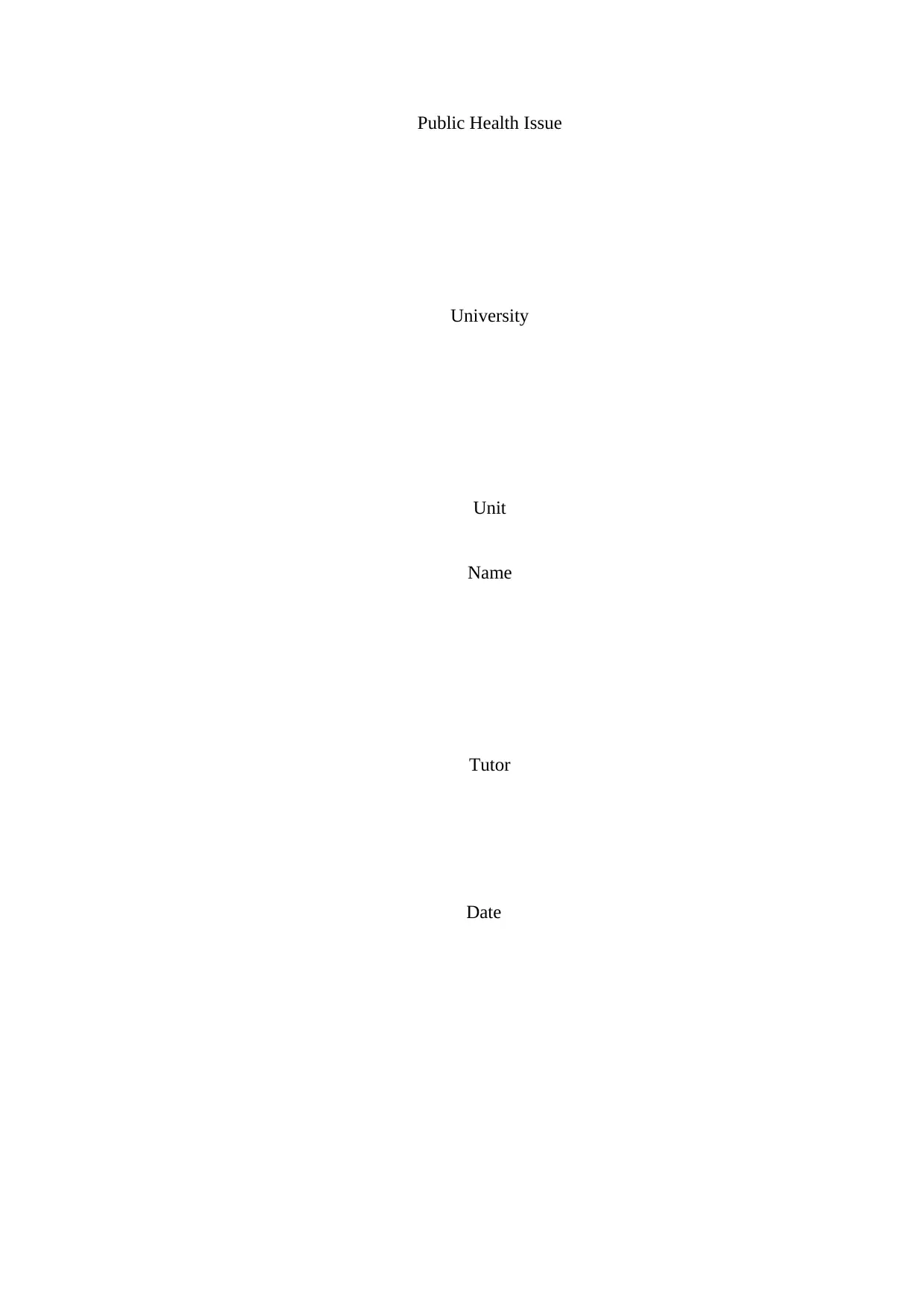
Public Health Issue
University
Unit
Name
Tutor
Date
University
Unit
Name
Tutor
Date
Paraphrase This Document
Need a fresh take? Get an instant paraphrase of this document with our AI Paraphraser
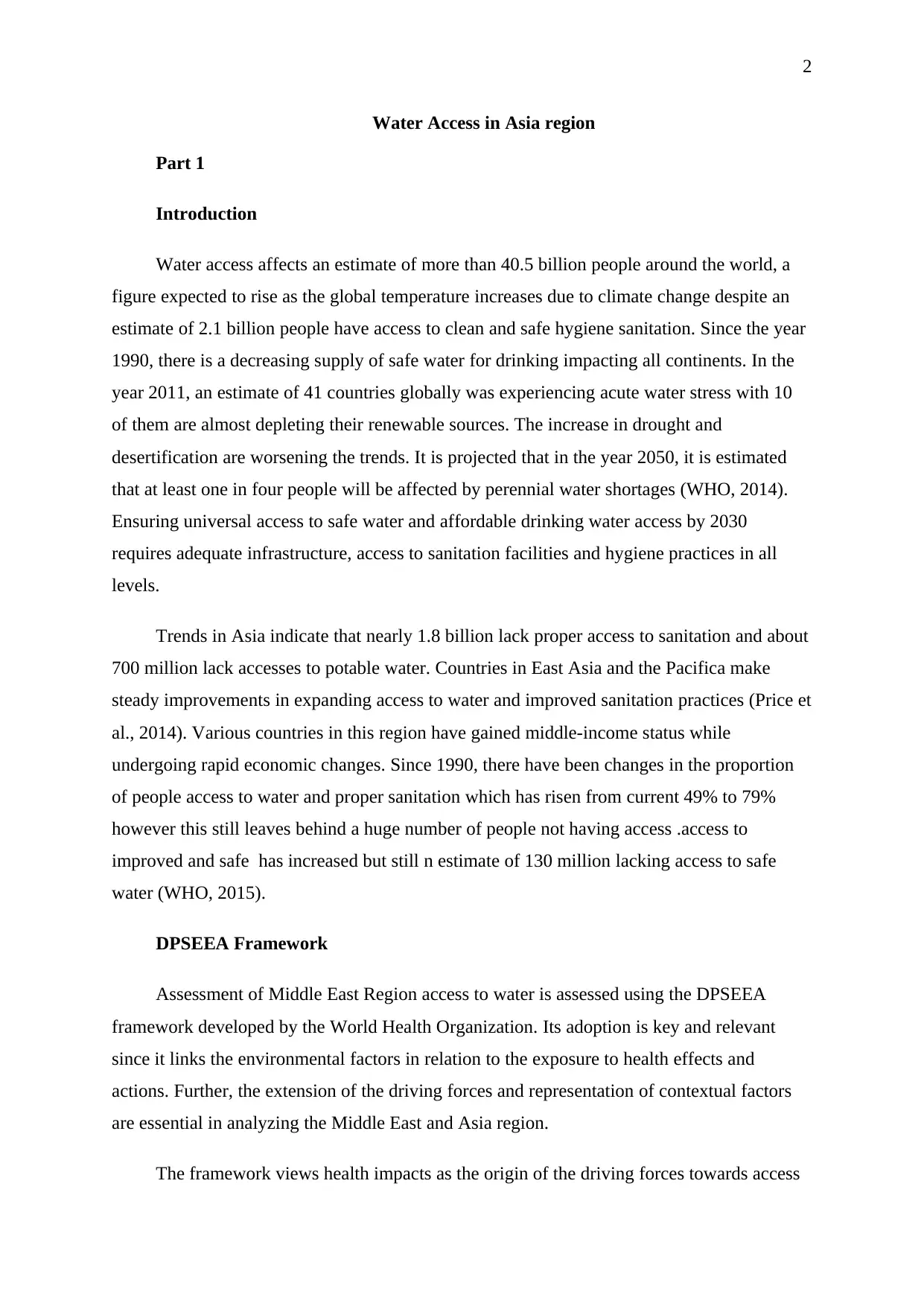
2
Water Access in Asia region
Part 1
Introduction
Water access affects an estimate of more than 40.5 billion people around the world, a
figure expected to rise as the global temperature increases due to climate change despite an
estimate of 2.1 billion people have access to clean and safe hygiene sanitation. Since the year
1990, there is a decreasing supply of safe water for drinking impacting all continents. In the
year 2011, an estimate of 41 countries globally was experiencing acute water stress with 10
of them are almost depleting their renewable sources. The increase in drought and
desertification are worsening the trends. It is projected that in the year 2050, it is estimated
that at least one in four people will be affected by perennial water shortages (WHO, 2014).
Ensuring universal access to safe water and affordable drinking water access by 2030
requires adequate infrastructure, access to sanitation facilities and hygiene practices in all
levels.
Trends in Asia indicate that nearly 1.8 billion lack proper access to sanitation and about
700 million lack accesses to potable water. Countries in East Asia and the Pacifica make
steady improvements in expanding access to water and improved sanitation practices (Price et
al., 2014). Various countries in this region have gained middle-income status while
undergoing rapid economic changes. Since 1990, there have been changes in the proportion
of people access to water and proper sanitation which has risen from current 49% to 79%
however this still leaves behind a huge number of people not having access .access to
improved and safe has increased but still n estimate of 130 million lacking access to safe
water (WHO, 2015).
DPSEEA Framework
Assessment of Middle East Region access to water is assessed using the DPSEEA
framework developed by the World Health Organization. Its adoption is key and relevant
since it links the environmental factors in relation to the exposure to health effects and
actions. Further, the extension of the driving forces and representation of contextual factors
are essential in analyzing the Middle East and Asia region.
The framework views health impacts as the origin of the driving forces towards access
Water Access in Asia region
Part 1
Introduction
Water access affects an estimate of more than 40.5 billion people around the world, a
figure expected to rise as the global temperature increases due to climate change despite an
estimate of 2.1 billion people have access to clean and safe hygiene sanitation. Since the year
1990, there is a decreasing supply of safe water for drinking impacting all continents. In the
year 2011, an estimate of 41 countries globally was experiencing acute water stress with 10
of them are almost depleting their renewable sources. The increase in drought and
desertification are worsening the trends. It is projected that in the year 2050, it is estimated
that at least one in four people will be affected by perennial water shortages (WHO, 2014).
Ensuring universal access to safe water and affordable drinking water access by 2030
requires adequate infrastructure, access to sanitation facilities and hygiene practices in all
levels.
Trends in Asia indicate that nearly 1.8 billion lack proper access to sanitation and about
700 million lack accesses to potable water. Countries in East Asia and the Pacifica make
steady improvements in expanding access to water and improved sanitation practices (Price et
al., 2014). Various countries in this region have gained middle-income status while
undergoing rapid economic changes. Since 1990, there have been changes in the proportion
of people access to water and proper sanitation which has risen from current 49% to 79%
however this still leaves behind a huge number of people not having access .access to
improved and safe has increased but still n estimate of 130 million lacking access to safe
water (WHO, 2015).
DPSEEA Framework
Assessment of Middle East Region access to water is assessed using the DPSEEA
framework developed by the World Health Organization. Its adoption is key and relevant
since it links the environmental factors in relation to the exposure to health effects and
actions. Further, the extension of the driving forces and representation of contextual factors
are essential in analyzing the Middle East and Asia region.
The framework views health impacts as the origin of the driving forces towards access
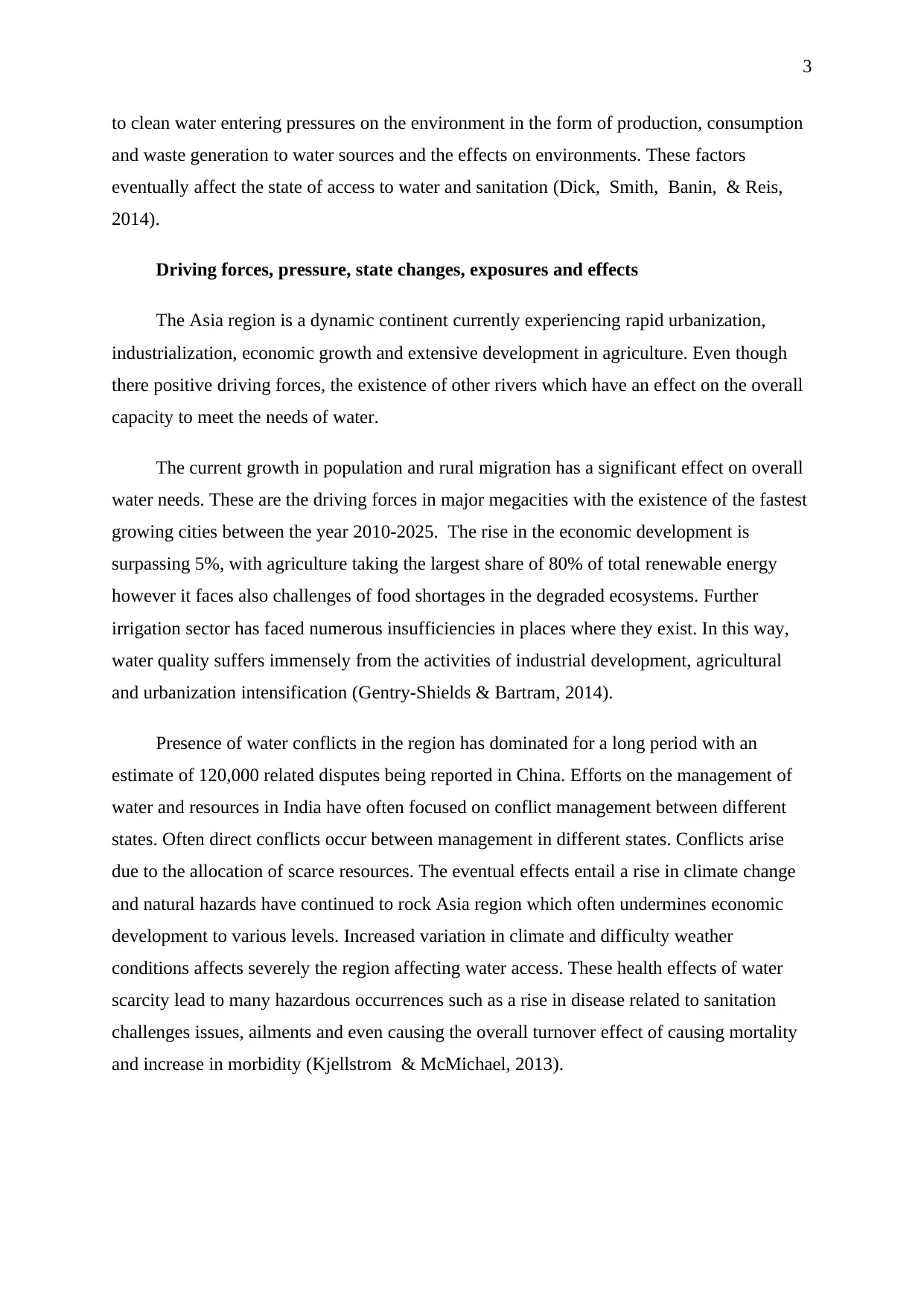
3
to clean water entering pressures on the environment in the form of production, consumption
and waste generation to water sources and the effects on environments. These factors
eventually affect the state of access to water and sanitation (Dick, Smith, Banin, & Reis,
2014).
Driving forces, pressure, state changes, exposures and effects
The Asia region is a dynamic continent currently experiencing rapid urbanization,
industrialization, economic growth and extensive development in agriculture. Even though
there positive driving forces, the existence of other rivers which have an effect on the overall
capacity to meet the needs of water.
The current growth in population and rural migration has a significant effect on overall
water needs. These are the driving forces in major megacities with the existence of the fastest
growing cities between the year 2010-2025. The rise in the economic development is
surpassing 5%, with agriculture taking the largest share of 80% of total renewable energy
however it faces also challenges of food shortages in the degraded ecosystems. Further
irrigation sector has faced numerous insufficiencies in places where they exist. In this way,
water quality suffers immensely from the activities of industrial development, agricultural
and urbanization intensification (Gentry-Shields & Bartram, 2014).
Presence of water conflicts in the region has dominated for a long period with an
estimate of 120,000 related disputes being reported in China. Efforts on the management of
water and resources in India have often focused on conflict management between different
states. Often direct conflicts occur between management in different states. Conflicts arise
due to the allocation of scarce resources. The eventual effects entail a rise in climate change
and natural hazards have continued to rock Asia region which often undermines economic
development to various levels. Increased variation in climate and difficulty weather
conditions affects severely the region affecting water access. These health effects of water
scarcity lead to many hazardous occurrences such as a rise in disease related to sanitation
challenges issues, ailments and even causing the overall turnover effect of causing mortality
and increase in morbidity (Kjellstrom & McMichael, 2013).
to clean water entering pressures on the environment in the form of production, consumption
and waste generation to water sources and the effects on environments. These factors
eventually affect the state of access to water and sanitation (Dick, Smith, Banin, & Reis,
2014).
Driving forces, pressure, state changes, exposures and effects
The Asia region is a dynamic continent currently experiencing rapid urbanization,
industrialization, economic growth and extensive development in agriculture. Even though
there positive driving forces, the existence of other rivers which have an effect on the overall
capacity to meet the needs of water.
The current growth in population and rural migration has a significant effect on overall
water needs. These are the driving forces in major megacities with the existence of the fastest
growing cities between the year 2010-2025. The rise in the economic development is
surpassing 5%, with agriculture taking the largest share of 80% of total renewable energy
however it faces also challenges of food shortages in the degraded ecosystems. Further
irrigation sector has faced numerous insufficiencies in places where they exist. In this way,
water quality suffers immensely from the activities of industrial development, agricultural
and urbanization intensification (Gentry-Shields & Bartram, 2014).
Presence of water conflicts in the region has dominated for a long period with an
estimate of 120,000 related disputes being reported in China. Efforts on the management of
water and resources in India have often focused on conflict management between different
states. Often direct conflicts occur between management in different states. Conflicts arise
due to the allocation of scarce resources. The eventual effects entail a rise in climate change
and natural hazards have continued to rock Asia region which often undermines economic
development to various levels. Increased variation in climate and difficulty weather
conditions affects severely the region affecting water access. These health effects of water
scarcity lead to many hazardous occurrences such as a rise in disease related to sanitation
challenges issues, ailments and even causing the overall turnover effect of causing mortality
and increase in morbidity (Kjellstrom & McMichael, 2013).
⊘ This is a preview!⊘
Do you want full access?
Subscribe today to unlock all pages.

Trusted by 1+ million students worldwide
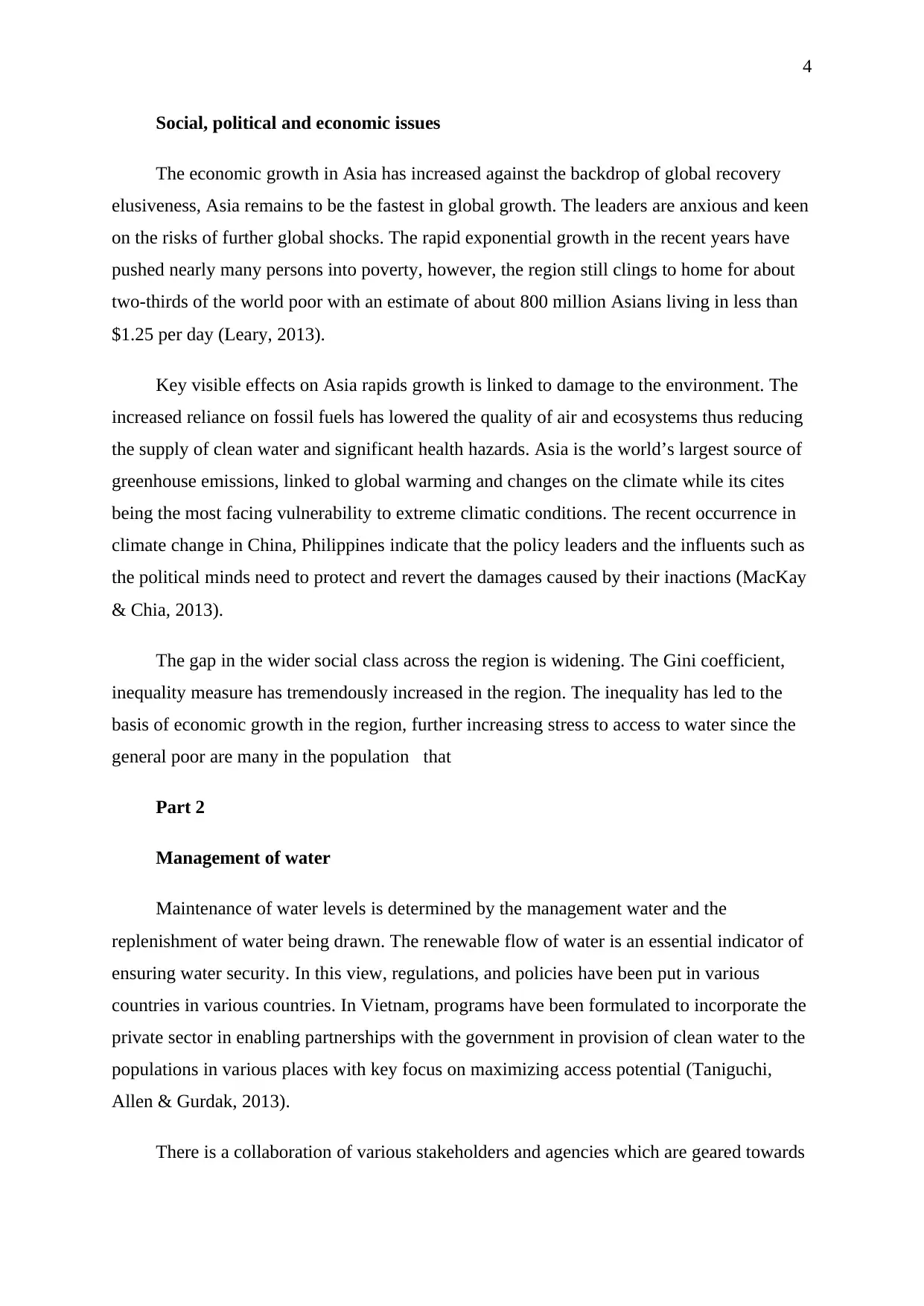
4
Social, political and economic issues
The economic growth in Asia has increased against the backdrop of global recovery
elusiveness, Asia remains to be the fastest in global growth. The leaders are anxious and keen
on the risks of further global shocks. The rapid exponential growth in the recent years have
pushed nearly many persons into poverty, however, the region still clings to home for about
two-thirds of the world poor with an estimate of about 800 million Asians living in less than
$1.25 per day (Leary, 2013).
Key visible effects on Asia rapids growth is linked to damage to the environment. The
increased reliance on fossil fuels has lowered the quality of air and ecosystems thus reducing
the supply of clean water and significant health hazards. Asia is the world’s largest source of
greenhouse emissions, linked to global warming and changes on the climate while its cites
being the most facing vulnerability to extreme climatic conditions. The recent occurrence in
climate change in China, Philippines indicate that the policy leaders and the influents such as
the political minds need to protect and revert the damages caused by their inactions (MacKay
& Chia, 2013).
The gap in the wider social class across the region is widening. The Gini coefficient,
inequality measure has tremendously increased in the region. The inequality has led to the
basis of economic growth in the region, further increasing stress to access to water since the
general poor are many in the population that
Part 2
Management of water
Maintenance of water levels is determined by the management water and the
replenishment of water being drawn. The renewable flow of water is an essential indicator of
ensuring water security. In this view, regulations, and policies have been put in various
countries in various countries. In Vietnam, programs have been formulated to incorporate the
private sector in enabling partnerships with the government in provision of clean water to the
populations in various places with key focus on maximizing access potential (Taniguchi,
Allen & Gurdak, 2013).
There is a collaboration of various stakeholders and agencies which are geared towards
Social, political and economic issues
The economic growth in Asia has increased against the backdrop of global recovery
elusiveness, Asia remains to be the fastest in global growth. The leaders are anxious and keen
on the risks of further global shocks. The rapid exponential growth in the recent years have
pushed nearly many persons into poverty, however, the region still clings to home for about
two-thirds of the world poor with an estimate of about 800 million Asians living in less than
$1.25 per day (Leary, 2013).
Key visible effects on Asia rapids growth is linked to damage to the environment. The
increased reliance on fossil fuels has lowered the quality of air and ecosystems thus reducing
the supply of clean water and significant health hazards. Asia is the world’s largest source of
greenhouse emissions, linked to global warming and changes on the climate while its cites
being the most facing vulnerability to extreme climatic conditions. The recent occurrence in
climate change in China, Philippines indicate that the policy leaders and the influents such as
the political minds need to protect and revert the damages caused by their inactions (MacKay
& Chia, 2013).
The gap in the wider social class across the region is widening. The Gini coefficient,
inequality measure has tremendously increased in the region. The inequality has led to the
basis of economic growth in the region, further increasing stress to access to water since the
general poor are many in the population that
Part 2
Management of water
Maintenance of water levels is determined by the management water and the
replenishment of water being drawn. The renewable flow of water is an essential indicator of
ensuring water security. In this view, regulations, and policies have been put in various
countries in various countries. In Vietnam, programs have been formulated to incorporate the
private sector in enabling partnerships with the government in provision of clean water to the
populations in various places with key focus on maximizing access potential (Taniguchi,
Allen & Gurdak, 2013).
There is a collaboration of various stakeholders and agencies which are geared towards
Paraphrase This Document
Need a fresh take? Get an instant paraphrase of this document with our AI Paraphraser
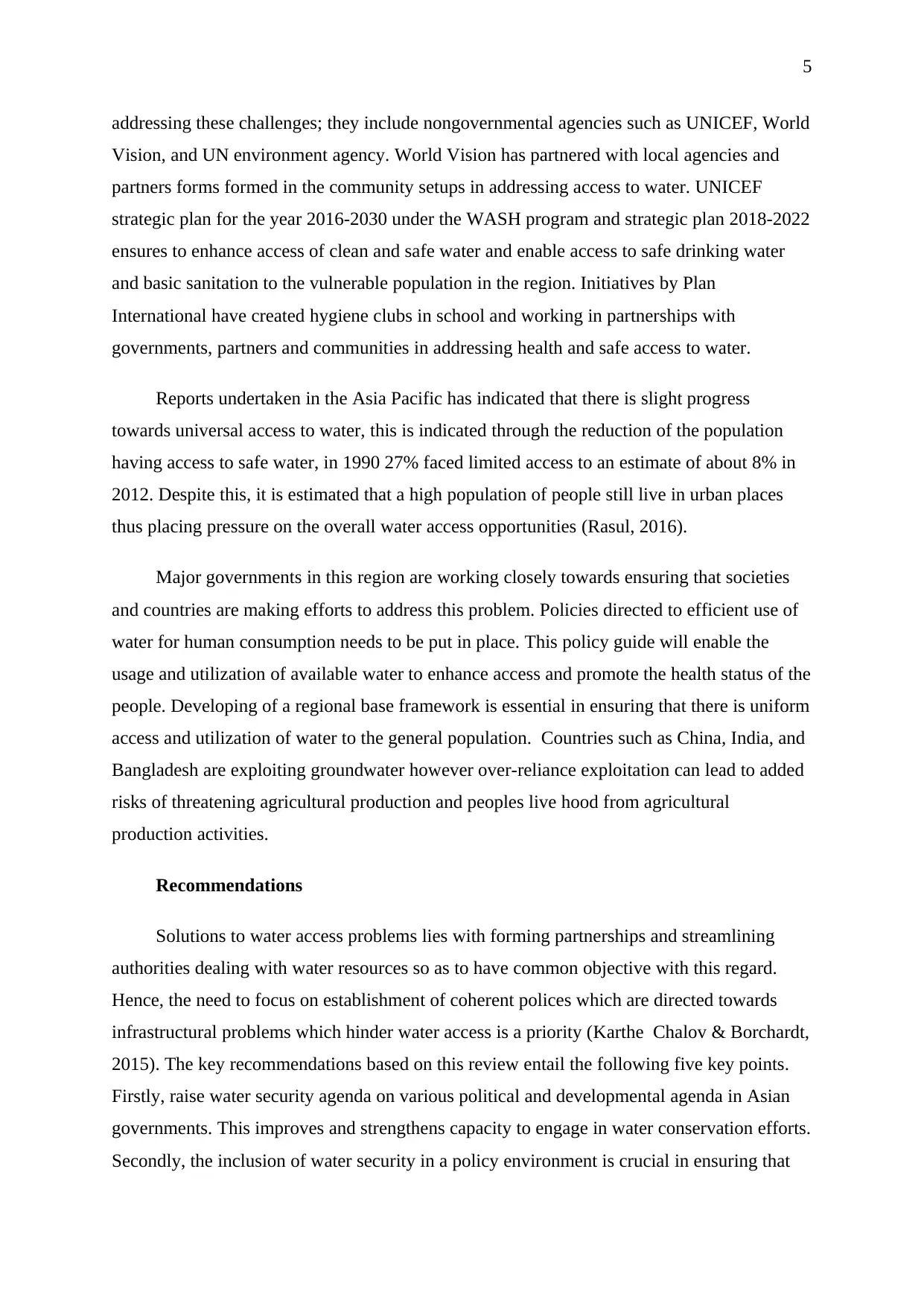
5
addressing these challenges; they include nongovernmental agencies such as UNICEF, World
Vision, and UN environment agency. World Vision has partnered with local agencies and
partners forms formed in the community setups in addressing access to water. UNICEF
strategic plan for the year 2016-2030 under the WASH program and strategic plan 2018-2022
ensures to enhance access of clean and safe water and enable access to safe drinking water
and basic sanitation to the vulnerable population in the region. Initiatives by Plan
International have created hygiene clubs in school and working in partnerships with
governments, partners and communities in addressing health and safe access to water.
Reports undertaken in the Asia Pacific has indicated that there is slight progress
towards universal access to water, this is indicated through the reduction of the population
having access to safe water, in 1990 27% faced limited access to an estimate of about 8% in
2012. Despite this, it is estimated that a high population of people still live in urban places
thus placing pressure on the overall water access opportunities (Rasul, 2016).
Major governments in this region are working closely towards ensuring that societies
and countries are making efforts to address this problem. Policies directed to efficient use of
water for human consumption needs to be put in place. This policy guide will enable the
usage and utilization of available water to enhance access and promote the health status of the
people. Developing of a regional base framework is essential in ensuring that there is uniform
access and utilization of water to the general population. Countries such as China, India, and
Bangladesh are exploiting groundwater however over-reliance exploitation can lead to added
risks of threatening agricultural production and peoples live hood from agricultural
production activities.
Recommendations
Solutions to water access problems lies with forming partnerships and streamlining
authorities dealing with water resources so as to have common objective with this regard.
Hence, the need to focus on establishment of coherent polices which are directed towards
infrastructural problems which hinder water access is a priority (Karthe Chalov & Borchardt,
2015). The key recommendations based on this review entail the following five key points.
Firstly, raise water security agenda on various political and developmental agenda in Asian
governments. This improves and strengthens capacity to engage in water conservation efforts.
Secondly, the inclusion of water security in a policy environment is crucial in ensuring that
addressing these challenges; they include nongovernmental agencies such as UNICEF, World
Vision, and UN environment agency. World Vision has partnered with local agencies and
partners forms formed in the community setups in addressing access to water. UNICEF
strategic plan for the year 2016-2030 under the WASH program and strategic plan 2018-2022
ensures to enhance access of clean and safe water and enable access to safe drinking water
and basic sanitation to the vulnerable population in the region. Initiatives by Plan
International have created hygiene clubs in school and working in partnerships with
governments, partners and communities in addressing health and safe access to water.
Reports undertaken in the Asia Pacific has indicated that there is slight progress
towards universal access to water, this is indicated through the reduction of the population
having access to safe water, in 1990 27% faced limited access to an estimate of about 8% in
2012. Despite this, it is estimated that a high population of people still live in urban places
thus placing pressure on the overall water access opportunities (Rasul, 2016).
Major governments in this region are working closely towards ensuring that societies
and countries are making efforts to address this problem. Policies directed to efficient use of
water for human consumption needs to be put in place. This policy guide will enable the
usage and utilization of available water to enhance access and promote the health status of the
people. Developing of a regional base framework is essential in ensuring that there is uniform
access and utilization of water to the general population. Countries such as China, India, and
Bangladesh are exploiting groundwater however over-reliance exploitation can lead to added
risks of threatening agricultural production and peoples live hood from agricultural
production activities.
Recommendations
Solutions to water access problems lies with forming partnerships and streamlining
authorities dealing with water resources so as to have common objective with this regard.
Hence, the need to focus on establishment of coherent polices which are directed towards
infrastructural problems which hinder water access is a priority (Karthe Chalov & Borchardt,
2015). The key recommendations based on this review entail the following five key points.
Firstly, raise water security agenda on various political and developmental agenda in Asian
governments. This improves and strengthens capacity to engage in water conservation efforts.
Secondly, the inclusion of water security in a policy environment is crucial in ensuring that
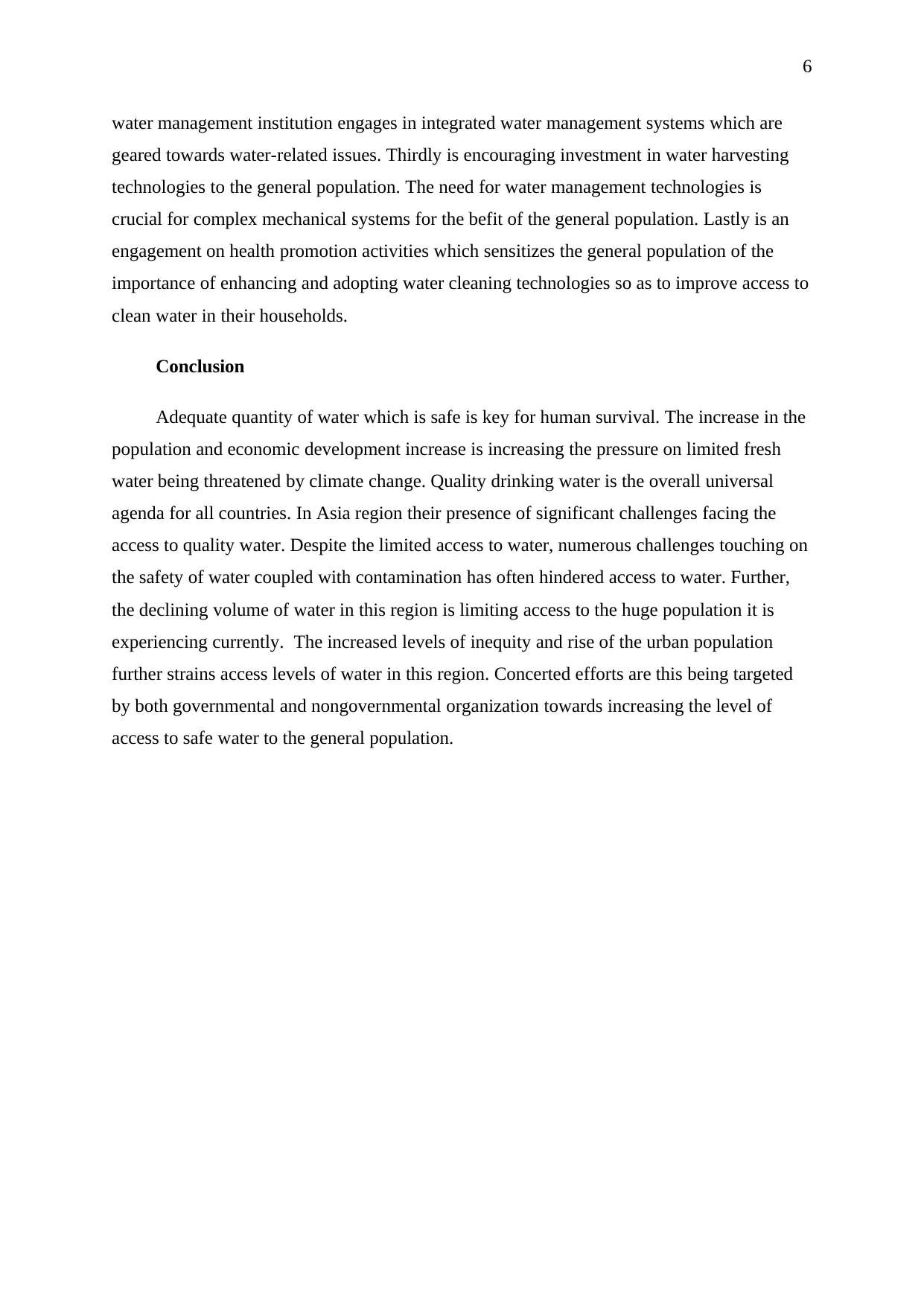
6
water management institution engages in integrated water management systems which are
geared towards water-related issues. Thirdly is encouraging investment in water harvesting
technologies to the general population. The need for water management technologies is
crucial for complex mechanical systems for the befit of the general population. Lastly is an
engagement on health promotion activities which sensitizes the general population of the
importance of enhancing and adopting water cleaning technologies so as to improve access to
clean water in their households.
Conclusion
Adequate quantity of water which is safe is key for human survival. The increase in the
population and economic development increase is increasing the pressure on limited fresh
water being threatened by climate change. Quality drinking water is the overall universal
agenda for all countries. In Asia region their presence of significant challenges facing the
access to quality water. Despite the limited access to water, numerous challenges touching on
the safety of water coupled with contamination has often hindered access to water. Further,
the declining volume of water in this region is limiting access to the huge population it is
experiencing currently. The increased levels of inequity and rise of the urban population
further strains access levels of water in this region. Concerted efforts are this being targeted
by both governmental and nongovernmental organization towards increasing the level of
access to safe water to the general population.
water management institution engages in integrated water management systems which are
geared towards water-related issues. Thirdly is encouraging investment in water harvesting
technologies to the general population. The need for water management technologies is
crucial for complex mechanical systems for the befit of the general population. Lastly is an
engagement on health promotion activities which sensitizes the general population of the
importance of enhancing and adopting water cleaning technologies so as to improve access to
clean water in their households.
Conclusion
Adequate quantity of water which is safe is key for human survival. The increase in the
population and economic development increase is increasing the pressure on limited fresh
water being threatened by climate change. Quality drinking water is the overall universal
agenda for all countries. In Asia region their presence of significant challenges facing the
access to quality water. Despite the limited access to water, numerous challenges touching on
the safety of water coupled with contamination has often hindered access to water. Further,
the declining volume of water in this region is limiting access to the huge population it is
experiencing currently. The increased levels of inequity and rise of the urban population
further strains access levels of water in this region. Concerted efforts are this being targeted
by both governmental and nongovernmental organization towards increasing the level of
access to safe water to the general population.
⊘ This is a preview!⊘
Do you want full access?
Subscribe today to unlock all pages.

Trusted by 1+ million students worldwide
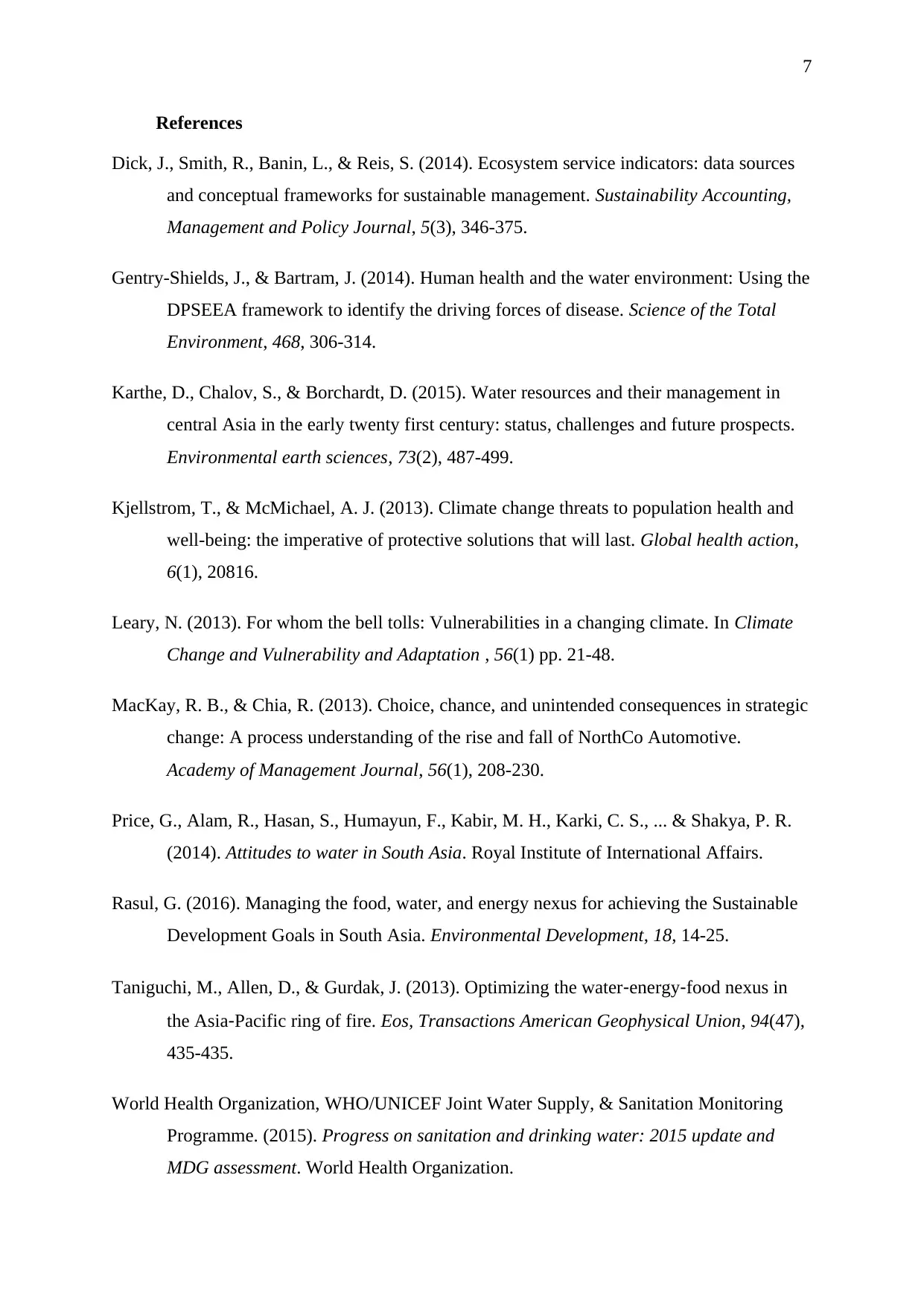
7
References
Dick, J., Smith, R., Banin, L., & Reis, S. (2014). Ecosystem service indicators: data sources
and conceptual frameworks for sustainable management. Sustainability Accounting,
Management and Policy Journal, 5(3), 346-375.
Gentry-Shields, J., & Bartram, J. (2014). Human health and the water environment: Using the
DPSEEA framework to identify the driving forces of disease. Science of the Total
Environment, 468, 306-314.
Karthe, D., Chalov, S., & Borchardt, D. (2015). Water resources and their management in
central Asia in the early twenty first century: status, challenges and future prospects.
Environmental earth sciences, 73(2), 487-499.
Kjellstrom, T., & McMichael, A. J. (2013). Climate change threats to population health and
well-being: the imperative of protective solutions that will last. Global health action,
6(1), 20816.
Leary, N. (2013). For whom the bell tolls: Vulnerabilities in a changing climate. In Climate
Change and Vulnerability and Adaptation , 56(1) pp. 21-48.
MacKay, R. B., & Chia, R. (2013). Choice, chance, and unintended consequences in strategic
change: A process understanding of the rise and fall of NorthCo Automotive.
Academy of Management Journal, 56(1), 208-230.
Price, G., Alam, R., Hasan, S., Humayun, F., Kabir, M. H., Karki, C. S., ... & Shakya, P. R.
(2014). Attitudes to water in South Asia. Royal Institute of International Affairs.
Rasul, G. (2016). Managing the food, water, and energy nexus for achieving the Sustainable
Development Goals in South Asia. Environmental Development, 18, 14-25.
Taniguchi, M., Allen, D., & Gurdak, J. (2013). Optimizing the water‐energy‐food nexus in
the Asia‐Pacific ring of fire. Eos, Transactions American Geophysical Union, 94(47),
435-435.
World Health Organization, WHO/UNICEF Joint Water Supply, & Sanitation Monitoring
Programme. (2015). Progress on sanitation and drinking water: 2015 update and
MDG assessment. World Health Organization.
References
Dick, J., Smith, R., Banin, L., & Reis, S. (2014). Ecosystem service indicators: data sources
and conceptual frameworks for sustainable management. Sustainability Accounting,
Management and Policy Journal, 5(3), 346-375.
Gentry-Shields, J., & Bartram, J. (2014). Human health and the water environment: Using the
DPSEEA framework to identify the driving forces of disease. Science of the Total
Environment, 468, 306-314.
Karthe, D., Chalov, S., & Borchardt, D. (2015). Water resources and their management in
central Asia in the early twenty first century: status, challenges and future prospects.
Environmental earth sciences, 73(2), 487-499.
Kjellstrom, T., & McMichael, A. J. (2013). Climate change threats to population health and
well-being: the imperative of protective solutions that will last. Global health action,
6(1), 20816.
Leary, N. (2013). For whom the bell tolls: Vulnerabilities in a changing climate. In Climate
Change and Vulnerability and Adaptation , 56(1) pp. 21-48.
MacKay, R. B., & Chia, R. (2013). Choice, chance, and unintended consequences in strategic
change: A process understanding of the rise and fall of NorthCo Automotive.
Academy of Management Journal, 56(1), 208-230.
Price, G., Alam, R., Hasan, S., Humayun, F., Kabir, M. H., Karki, C. S., ... & Shakya, P. R.
(2014). Attitudes to water in South Asia. Royal Institute of International Affairs.
Rasul, G. (2016). Managing the food, water, and energy nexus for achieving the Sustainable
Development Goals in South Asia. Environmental Development, 18, 14-25.
Taniguchi, M., Allen, D., & Gurdak, J. (2013). Optimizing the water‐energy‐food nexus in
the Asia‐Pacific ring of fire. Eos, Transactions American Geophysical Union, 94(47),
435-435.
World Health Organization, WHO/UNICEF Joint Water Supply, & Sanitation Monitoring
Programme. (2015). Progress on sanitation and drinking water: 2015 update and
MDG assessment. World Health Organization.
Paraphrase This Document
Need a fresh take? Get an instant paraphrase of this document with our AI Paraphraser
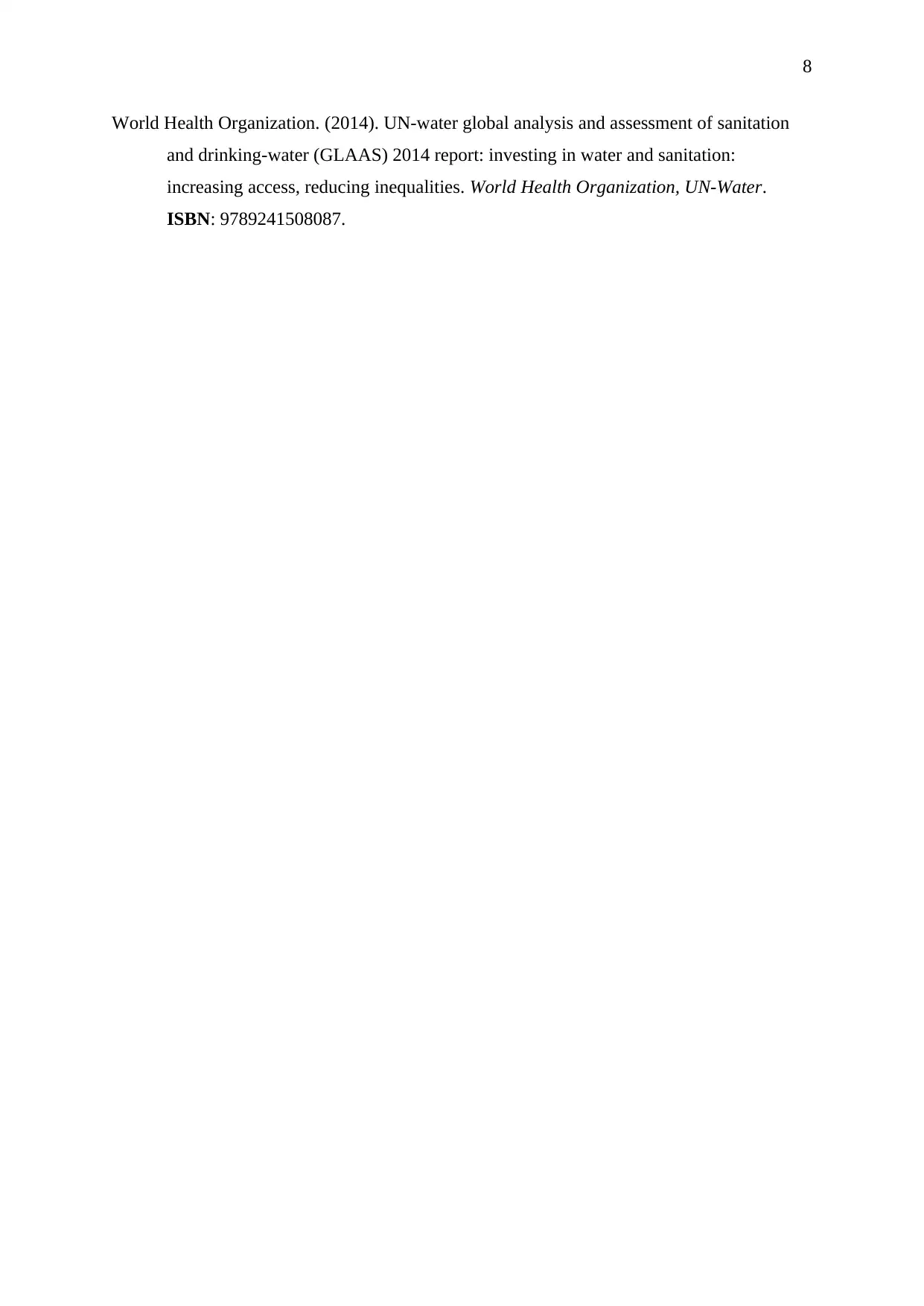
8
World Health Organization. (2014). UN-water global analysis and assessment of sanitation
and drinking-water (GLAAS) 2014 report: investing in water and sanitation:
increasing access, reducing inequalities. World Health Organization, UN-Water.
ISBN: 9789241508087.
World Health Organization. (2014). UN-water global analysis and assessment of sanitation
and drinking-water (GLAAS) 2014 report: investing in water and sanitation:
increasing access, reducing inequalities. World Health Organization, UN-Water.
ISBN: 9789241508087.
1 out of 8
Related Documents
Your All-in-One AI-Powered Toolkit for Academic Success.
+13062052269
info@desklib.com
Available 24*7 on WhatsApp / Email
![[object Object]](/_next/static/media/star-bottom.7253800d.svg)
Unlock your academic potential
Copyright © 2020–2025 A2Z Services. All Rights Reserved. Developed and managed by ZUCOL.





